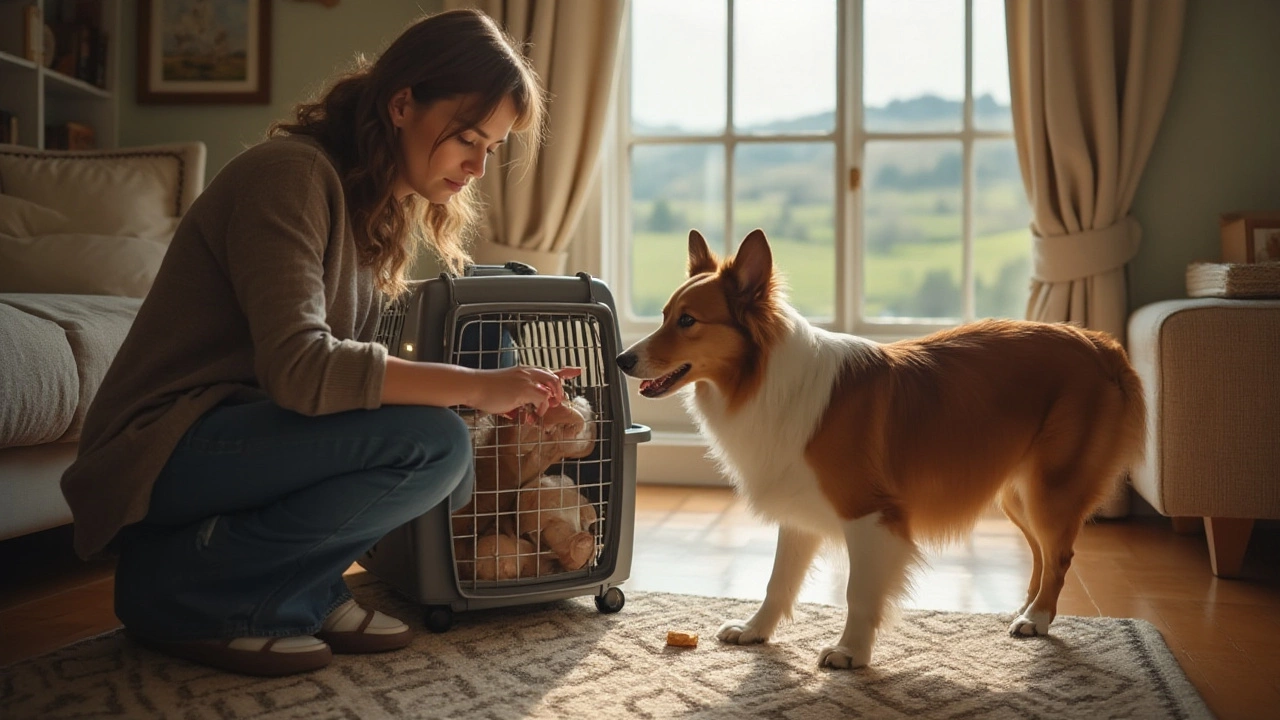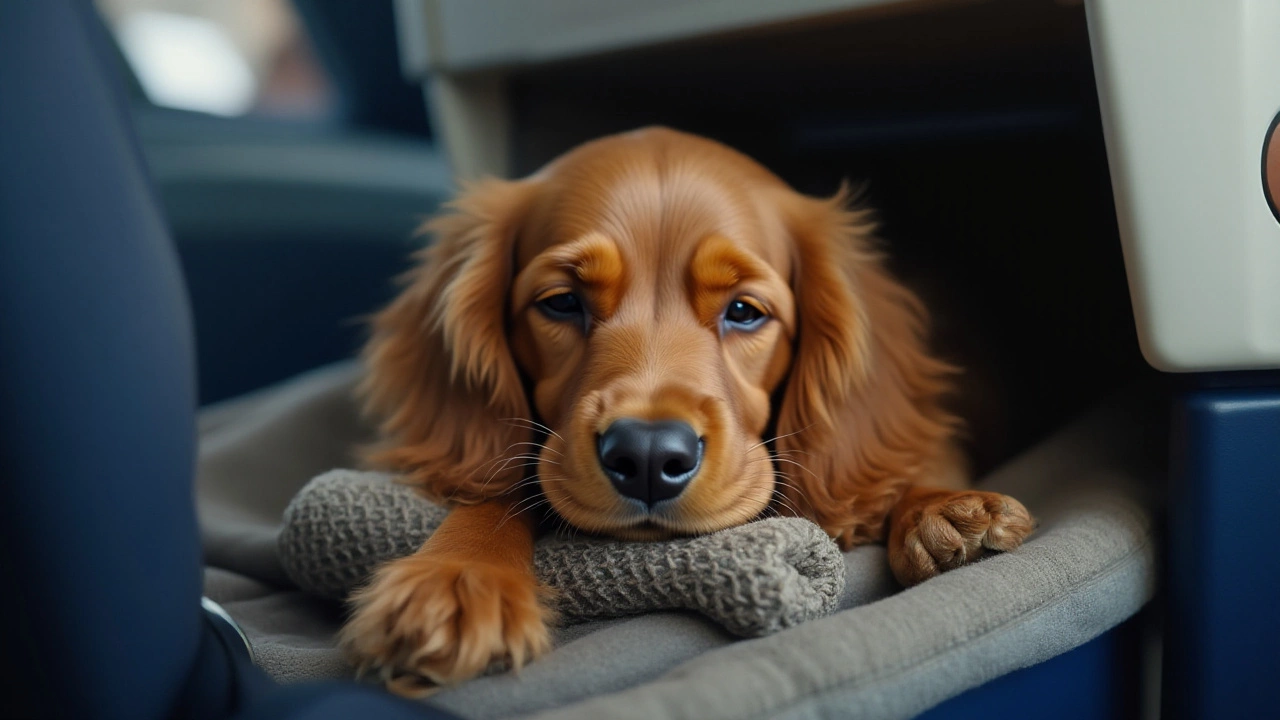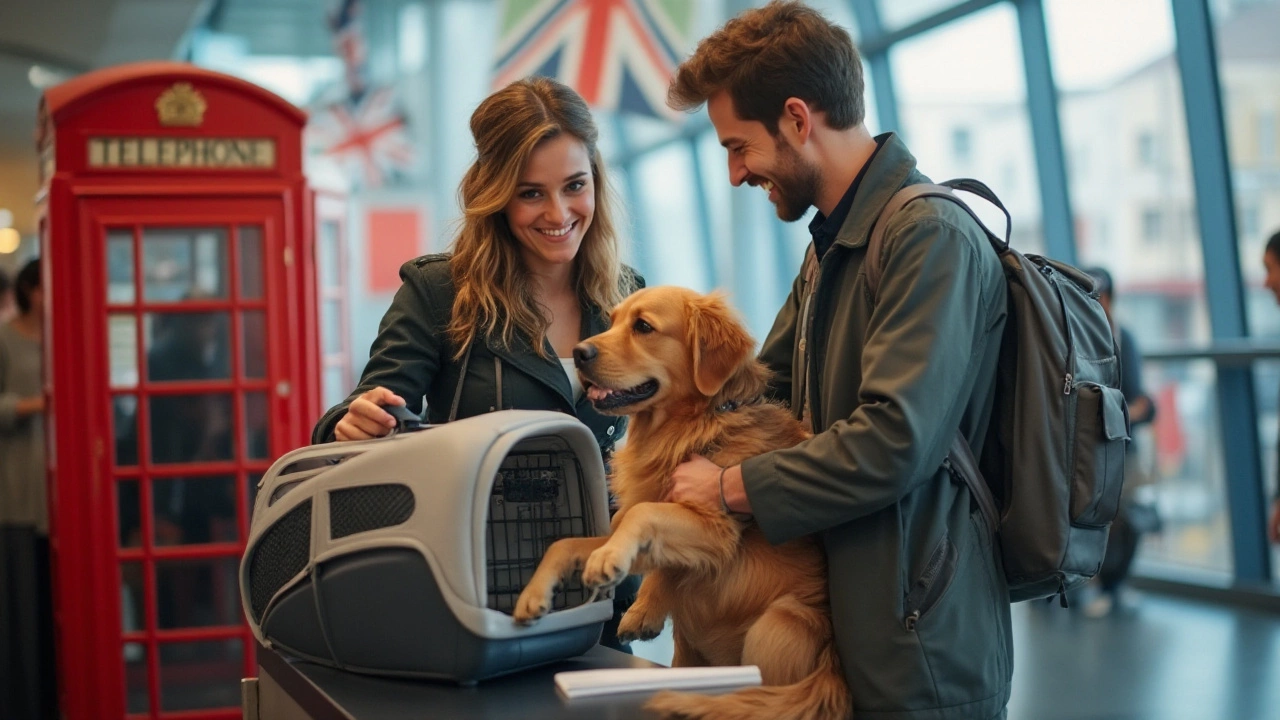Jet-setting with your furry family member might sound like an adventure, and it absolutely can be—as long as you're armed with the right information. Picture this: you, your 50lb furry friend, and the open skies! Preparing to take your dog on a plane requires more than just the spirit of adventure; it demands understanding specific airline policies, selecting the right travel equipment, and ensuring your dog is comfortable and safe.
Many pet parents dream of taking Fido with them wherever they go, but flying with a dog of this size involves deciphering guidelines and planning ahead. From choosing the proper pet carrier to acclimating your pooch to confined spaces, each step needs careful attention. But fear not, with some preparation, your voyage can be as seamless as a gentle stroll in the park. Let's dive into what it takes to make this airborne journey with your beloved pet a pleasant experience!
- Airline Policies and Guidelines
- Choosing the Right Carrier
- Preparing Your Dog for Travel
- What to Expect at the Airport
- Keeping Your Dog Calm During the Flight
Airline Policies and Guidelines
Planning to embark on an aerial adventure with your furry companion? The first and most crucial step is to acquaint yourself with the airline policies related to pet travel, as guidelines can vary significantly from one airline to another. Typically, airlines categorize pets by size and weight, with your beloved 50lb dog falling into the 'medium to large' category—often requiring a special set of conditions.
Most airlines require pets over a certain size to travel in the cargo hold rather than the cabin, but don't let that worry you. Modern aircraft are equipped with pressurized and temperature-controlled compartments to ensure your pet's comfort throughout the flight. Airlines like United, Delta, and American have specific programs designed for pet safety. For example, United's "PetSafe" program offers tracking services to keep you informed about your pet's location and status during the journey.
Notably, it’s essential to make a reservation for your dog as soon as you book your ticket, because airlines often limit the number of animals they transport per flight. Also, some countries and airlines may have breed restrictions or require specific health documentation, like up-to-date vaccination records or even a pet passport. Speaking of documentation, a well-known pet travel expert once shared,
"Preparation is key. Ensure you have all necessary paperwork in order several weeks before your scheduled departure date."This advice rings true, especially for international flights, which can have additional requirements.
In preparation, check the airline's pet travel policy online or directly contact their customer service. Official websites provide detailed instructions and a list of necessary documents each passenger should carry. One fun fact: airlines generally encourage owners to lightly sedate pets, but experts often advise against this option due to possible health risks. Thus, consult your veterinarian regarding the best course of action.
It’s also vital to buy an airline-approved pet carrier as it will be mandatory for boarding. These carriers are designed to ensure the safety and security of your dog while complying with airline standards. Trust us, taking a bit of time to familiarize yourself with these vital pet travel tips will make for a much smoother ride. Here is a quick reference table showing what some major airlines allow:
| Airline | Cabin Permitted | Cargo Hold | Maximum Weight |
|---|---|---|---|
| United | No | Yes | Unlimited (with conditions) |
| Delta | No | Yes | Up to 150 lbs |
| American | No | Yes | Max 100 lbs including carrier |
Choosing the Right Carrier
When it comes to air travel with dogs, especially those tipping the scales at around 50lbs, the carrier is not just a container—it's your pet's sanctuary above the clouds. Selecting the right carrier is paramount for ensuring that both you and your furry friend enjoy the experience without a hitch. Given the plethora of options available, it may feel like a daunting task, but it's all about knowing what to look for.
Firstly, the most critical feature of any pet carrier is that it must comply with the specific airline's regulations. Airlines each have their own set of rules regarding acceptable dimensions and materials, and ignoring these can result in stressful last-minute scrambles at the airport. Some airlines are quite specific about the types of carriers allowed onboard, so check these details well ahead of your planned departure. An ideal carrier should allow your pet to stand, turn, and lie down comfortably. This is crucial as it impacts the stress levels of your dog during the flight.
A carrier made with durable material is non-negotiable. Look for those crafted from reinforced plastic or metal for hard-sided carriers, or thick, resilient fabric for soft-sided ones. This durability ensures that the carrier withstands the rigors of travel while providing a safe cocoon where your dog can feel secure. Ventilation is another key factor; a well-ventilated carrier with mesh panels or multiple air holes helps keep the airflow steady, which is essential for your dog’s comfort and health during air travel.
Portability is often overlooked but essential if the journey involves transfers within the airport or during other parts of your trip. Many pet carriers feature wheels and detachable straps, making mobility a breeze. Consider investing in these user-friendly options to ease the transition between check-in counters and boarding areas. Also, think about additional features like pockets for storing essentials such as leashes or travel documents. These little conveniences can make all the difference when you’re rushing to your gate.
Renowned pet behaviorist Dr. Emily Murray once said, "A dog’s carrier is more than just a means of transportation—it’s their haven during a journey. Choose one that provides both safety and a sense of familiarity to reduce anxiety."
If you’re a frequent traveler, doubling down on quality materials might save you headaches in the future. Airlines often accept carriers matching industry standards, like those endorsed by the International Air Transport Association (IATA). Investing in such a carrier can be financially savvy in the long run, as it reduces the chance of having to replace it regularly. Additionally, labels and stickers indicating "Live Animal" are often required and can be purchased alongside the carrier or online.
Let’s not forget about the carrier's interior! A comfortable lining or pad in your dog's carrier can significantly enhance their travel experience. While carriers often come with pads, consider upgrading to a plush, waterproof mat to better cushion your dog's journey, especially on long-haul flights. The right lining can also keep your pet warm or cool depending on the airplane cabin's fluctuating temperatures. Always test out the carrier with your dog before the trip—let them get comfortable and feel at home in it. This minimizes stress when the day of travel arrives, turning an unknown into a cozy, trusted space.

Preparing Your Dog for Travel
The anticipation of soaring through the skies with your canine companion can be thrilling yet daunting. To ensure both you and your pooch are ready for this venture, ample preparation is needed. Just like us, dogs appreciate a routine, and any deviation can cause unease, especially with the hustle and bustle of air travel. Start by familiarizing your furry friend with the pet carrier they will travel in. Leave it open in your home and encourage your dog to explore it at their own pace, rewarding them with treats and positive reinforcement. This helps create a safe space for your dog, making the experience less intimidating. Plan to take your dog on car trips inside the carrier to simulate the travel experience, getting them accustomed to the movement and confined space.
Another critical aspect is getting your pet vaccinated and ensuring their health to prevent complications. Schedule a visit to the vet to address any health concerns. Airlines often require health certificates, and some countries necessitate specific vaccinations or health checks that must be completed within a certain timeframe. It’s essential to research the destination’s regulations well ahead of time. Feeding your 50lb dog hours before the flight with a light meal can prevent nausea. Hydration is crucial, but avoid excessive water right before the trip.
Training and Mental Preparation
Behavioral training can play a significant role in how smoothly your journey unfolds. Teaching your dog to remain calm and follow simple commands can mitigate stress during the flight. Practice commands like ‘stay’ or ‘quiet’ regularly. Interactive toys or puzzles can occupy their attention during waiting times, like at the gate or while boarding. If your pooch is particularly anxious, consult your vet about suitable calming aids or medications. Remember, it is vital to do this well in advance of your travel date, so your dog can gradually adapt.
“Ensuring your dog is well-trained can significantly ease their stress during air travel,” advises the American Kennel Club. “A calm dog is a happy traveler.”
Introducing your dog to a variety of noises and environments also helps lessen the shock of a busy airport. Consider taking your dog to places bustling with activity, such as parks or pet-friendly events, to acclimate them to unfamiliar sounds and crowds. Positive association and exposure reduce anxiety levels, making the transition to travel life smoother for medium-sized dogs.
| Step | Action | Timeframe |
|---|---|---|
| 1 | Visit the vet for a check-up and required vaccinations. | 2 months before travel |
| 2 | Introduce the travel carrier to your dog. | 6 weeks before travel |
| 3 | Train your dog with basic calming commands. | Ongoing |
| 4 | Simulate travel conditions using car trips. | 4 weeks before travel |
What to Expect at the Airport
Arriving at the airport with your furry companion for the first time can be an entirely new experience, akin to entering an unfamiliar world brimming with new sounds, sights, and steps you'll need to take. It's important to start by arriving at least two to three hours early, especially as processing your canine at the check-in can be time-consuming. Airlines generally have designated counters for those flying with pets, and this is where you'll present your dog's health certificates, vaccination paperwork, and pay any necessary pet travel fees.
Once your documents are in order, you and your dog will proceed through security. The TSA requires that you carry your dog through the metal detector while their carrier goes through the X-ray machine, so make sure Fido is on a leash and comfortable being held. This is the perfect time to ensure that your dog is calmly secured and not anxious, as it's crucial to keep them at ease in such a bustling environment. The Transportation Security Administration reports that nearly two million pets fly annually, and with that volume, airports have adapted to ensure smoother experiences for both pets and humans.
After security, head towards your gate, but first, find out where the nearest pet relief area is located. Most major airports now feature these facilities, providing a small patch of artificial grass or mulch where your dog can take care of their business before boarding. Typically, they are within the secure area so you won't have to go through security again. This helps prevent any in-flight accidents, ensuring a more pleasant journey for everyone involved. It's also worth noting that dogs are often quite sensitive to changes in environment and may need a bit of encouragement to use these areas.
Waiting at the gate offers its own set of challenges. With people bustling around, overhead announcements, and the collective tension of travelers, it’s key to maintain your dog’s comfort through familiarity. Bring along their favorite toy, a comfort blanket, or some treats to keep them engaged and minimize stress. Flying with pets like a 50lb dog isn’t just about logistics but also managing their emotional state. According to pet travel expert Michele Crouse, "keeping a pet calm in airports is half the battle." This advice rings true, and with a bit of care and patience, the airport process can become a positive precursor to your adventure in the skies.
An unexpected delight might even be discovering other travelers eager to meet your furry friend. Many people find comfort and joy in interacting with animals, and this interaction can ease the tension of their own travels. This is not only beneficial to fellow travelers but also to your dog, who may enjoy these social moments and distractions while waiting to board. As you prepare to embark, keep your boarding documents handy and be aware of any final boarding announcements for adjustments in seating or procedures, ensuring your journey together gets off to a smooth start.

Keeping Your Dog Calm During the Flight
Imagine soaring thousands of feet above the ground, safely tucked away inside a flying metal tube. While many of us might find the notion exhilarating, it can be quite an overwhelming experience for our four-legged pals. Flying with your 50lb dog means ensuring they are as content and relaxed as possible during the entire process. The first step is creating a comfortable and secure environment within their carrier. Before heading to the airport, familiarize your dog with its travel crate by allowing it to spend ample time inside. Gradually increase the amount of time they spend in it, praising calm behavior and associating it with positive feelings through gentle reassurance and occasional treats.
To ease flying jitters, consider enlisting the help of calming products specifically designed for canines. Products such as pheromone sprays or anxiety wraps can work wonders in minimizing stress. Such aids have been around for years and are often recommended by veterinarians. You can also consider using natural remedies like chamomile or valerian root, but always consult your vet before introducing anything new to your dog's regimen. Just as distractions work for us humans, they work for dogs too! Pack their favorite chew toy or blanket, which carries the comforting scent of home—it’s like bringing a little piece of security on board.
Flying can be unpredictable, even for seasoned travelers. That's why staying attuned to your dog's behavior and needs is important. Perhaps your pooch isn't fond of confined spaces or loud noises. If possible, take trial car trips in the crate or simulate airplane sounds at a low volume to help desensitize them prior to air travel. Be aware that motion sickness can affect dogs as much as it does people. Feed your dog lightly a few hours before takeoff, as an empty stomach can minimize the risk of queasiness. Happy travel means ensuring your furry pal has had ample exercise before the journey; a long walk or run can work wonders in releasing pent-up energy and curbing any nervousness.
"Patience and preparation are key when flying with pets. The calmer you are, the more your dog will mirror your behavior," Sarah Hodgson, dog behavior specialist and author, once noted.
Communication with airline staff can also be pivotal. Inform the flight attendants about your dog, especially if the situation requires special arrangements. Some airlines are more pet-friendly than others, and their staff can be very understanding of your needs as a pet parent. It would be helpful to keep in mind that an informed staff is more likely to provide assistance. Encourage friendly interaction if your dog seems receptive—it can ease tension and provide a brief distraction. In addition, staying hydrated is paramount, not just for you, but for your dog as well. Carry a collapsible water bowl, and offer water during the flight when appropriate. The primary goal is to create a seamless experience, so the two of you can touch down in your new destination with tails wagging happily.
